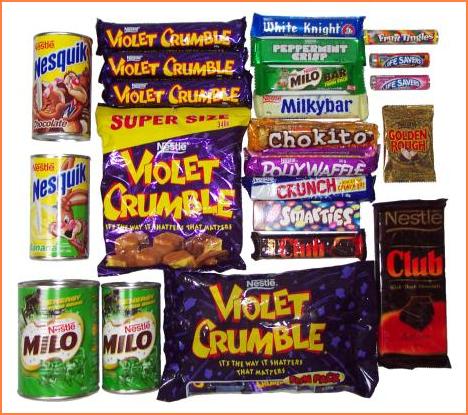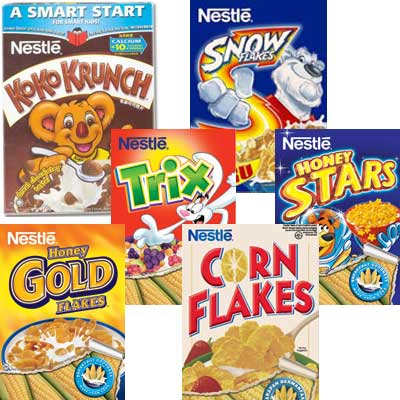Type | Société Anonyme |
Traded as | SIX: NESN |
Industry | Food processing |
Founded | Vevey, Switzerland (1866) |
Founder(s) | Henri Nestlé |
Headquarters | Vevey, Switzerland |
Area served | Worldwidedan MINUMANan Minuman |
Key people | Peter Brabeck-Letmathe (Chairman), Paul Bulcke (CEO) |
Products | Baby food, coffee, dairy products, breakfast cereals, confectionery, bottled water, ice cream, pet foods |
Revenue | CHF 109.72 billion (2010) |
Operating income | CHF 16.19 billion (2010) |
Profit | CHF 34.23 billion (2010) |
Total assets | CHF 111.64 billion (end 2010) |
Total equity | CHF 62.60 billion (end 2010) |
Employees | 281,000 (2010) |
Website |
Products
Nestlé has some 6,000 brands, with a wide range of products across a number of markets, including coffee (Nescafé, Nespresso, etc.), bottled water (Buxton, Perrier, etc.), milkshakes and other beverages (Nesquik, Milo, Carnation, etc.), chocolate (Milky Bar, After Eight, and many others), ice cream (Häagen-Dazs, Skinny Cow, etc.), breakfast cereals (Cheerios, Golden Nuggets, Shreddies, etc.), infant foods (now including Gerber products), performance and healthcare nutrition (Nesvita, PowerBar, etc.), seasonings, soups and sauces (Maggi, Buitoni, etc.), frozen and refrigerated foods (Findus, Lean Cuisine, etc.), confectionery (Rowntree products, Caramac, Wonka products, etc.), and pet food (Winalot, Felix).
In September 1867 in Vevey Henri Nestlé developed a milk-based baby food, and soon began marketing it. The following year saw Daniel Peter begin seven years of work perfecting his invention, the milk chocolate manufacturing process. Nestlé's was the crucial cooperation that Peter needed to solve the problem of removing all the water from the milk added to his chocolate and thus preventing the product from developing mildew. Henri Nestlé retired in 1875 but the company under new ownership retained his name as Farine Lactée Henri Nestlé.In 1877 Anglo-Swiss added milk-based baby foods to their products and in the following year the Nestlé Company added condensed milk so that the firms became direct and fierce rivals.In 1905 the companies merged to become the Nestlé and Anglo-Swiss Condensed Milk Company, retaining that name until 1947 .
Controversy and criticism
- Marketing of formula
One of the most prominent controversies involving Nestlé concerns the promotion of the use of infant formula to mothers across the world, including developing countries – an issue that attracted significant attention in 1977 as a result of the Nestlé boycott, which is still on going.
- Ethiopian debt
In 2002, Nestlé demanded that the nation of Ethiopia repay $6 million of debt to the company. Ethiopia was suffering a severe famine at the time. Nestlé backed down from its demand after more than 8,500 people complained via e-mail to the company about its treatment of the Ethiopian government.
- Melamine in Chinese milk
In late September 2008, the Hong Kong government claimed to have found melamine in a Chinese-made Nestlé milk product. The Dairy Farm milk was made by Nestlé's division in the Chinese coastal city Qingdao.
- Greenwashing
A coalition of environmental groups filed a complaint against Nestlé to the Canadian Code of Advertising Standards after Nestlé took out full-page advertisements in October 2008 claiming that "Most water bottles avoid landfill sites and are recycled", "Nestlé Pure Life is a healthy, eco-friendly choice" and that "Bottled water is the most environmentally responsible consumer product in the world".
- Child labour
The 2010 documentary The Dark Side of Chocolate alleges that Nestlé purchases cocoa beans from Ivory Coast plantations that use child slave labour. The children are usually 12 to 15 years old, and some are trafficked from nearby countries. In September 2001, Bradley Alford, Chairman and CEO of Nestlé USA, signed the Harkin-Engel Protocol (commonly called the Cocoa Protocol), an international agreement aimed at ending child labour in the production of cocoa.
Business Strategies
- Joint ventures
Nestlé holds 26.4% of the shares of L'Oréal, the world's largest company in cosmetics and beauty. The Laboratoires Inneov is a joint venture in nutritional cosmetics between Nestlé and L'Oréal, while Galderma is a joint venture in dermatology with L'Oréal. Others joint ventures include Cereal Partners Worldwide with General Mills, Beverage Partners Worldwide with Coca-Cola, and Dairy Partners Americas with Fonterra.
- Ethical and sustainable efforts
Nestlé is a founding participant in the International Cocoa Initiative (ICI), an independent foundation set up in 2002 and dedicated to ending child and forced labour in cocoa growing, and eliminating child trafficking and abusive labour practices. However, there is little evidence that Nestlé has reduced any of its child labour practices in countries such as the Ivory Coast.
In October 2009, Nestlé announced its Cocoa Plan. The company will invest CHF 110 million over ten years to achieve a sustainable cocoa supply. On 23 October 2009, Nestlé and CNRA (the Ivorian National Centre for Plant Science Research), signed a frame agreement for cooperation in plant science and propagation, with a target of producing 1 million high-quality, disease-resistant cocoa plantlets a year by 2012. The aim is to replace old, less productive trees with healthier new ones.




0 comments:
Post a Comment